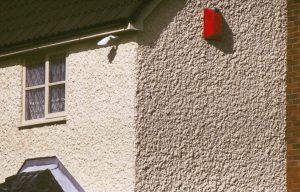When they do a roughcast render Edinburgh tradesmen may also refer to it as ‘wet-dash’, though in Scotland the term you are more likely to here is ‘harling’. This is a roughcast render Edinburgh teams use that to create a coarse finishing coat containing gravel thrown in a premixed state onto a wall.
This kind of render is very distinct from pebble dash, or ‘dry dash’, in which the aggregate is applied separately onto wet plaster. Historically, when roughcasting Edinburgh workmen used this for rural buildings, where it was popular across much of the UK, except the south-eastern half of England. It was also sometimes employed for high status Arts and Crafts buildings too.
When compared to smooth render, this roughcast render is particularly advantageous in exposed areas as it has a heavy texture that creates a larger surface area, a roughcast render Edinburgh tradesmen use a lot as it aids and helps with moisture absorption and evaporation.
Additionally, the application method allows use of a mortar mix less prone to shrinkage while curing.
Before applying new roughcast Edinburgh roughcasters will always remove detached render beyond saving. When loose edges repeatedly dampened become sufficiently pliable to resecure with lime slurry grout (and, if needed, screws and washers); the new roughcast render finishing coat is ‘feathered’ over the reattached edges. It is unnecessary, in most cases, to rake out mortar joints, and always inadvisable to hack masonry faces, to provide a key for new roughcast.
When it comes to roughcasting Edinburgh roughcasters know that several thin coats are better than one thick one.
The underlying coat(s), as well as the finishing coat, may be roughcast, rather than laid on smooth, if preferred. Roughcast can be machine-applied but hand-casting is as quick for an average-sized house. One method is to throw the mix ‘backhand’ from a casting (‘dashing’) float or cut-down coal shovel.

